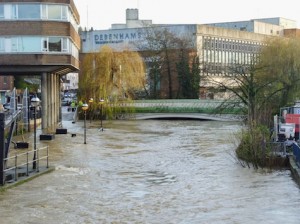 Abraham Lincoln
If given the truth, the people can be depended upon to meet any national crisis...
Abraham Lincoln
If given the truth, the people can be depended upon to meet any national crisis...
 Guildford news...
for Guildford people, brought to you by Guildford reporters - Guildford's own news service
Guildford news...
for Guildford people, brought to you by Guildford reporters - Guildford's own news service
Letter: What Is the Real Purpose of the Flood Alleviation Scheme?
Published on: 11 Apr, 2024
Updated on: 11 Apr, 2024
In response to: Flood Alleviation Scheme is Guildford’s ‘Biggest Opportunity Since 1900’
The article cites Mr Rigg as saying: “When the Government said Guildford had to deliver 10,000 homes, they had to all go in the green belt and the villages, because nobody got the flooding scheme underway and released the brownfield sites.”
This statement is highly misleading. It is not true that the Government chose Guildford’s housing target – the borough council did that. The then Conservative council went for the largest possible housing target by refusing to apply any constraints and to provide an ‘exceptional circumstance’ to justify building on the green belt.
It is not true that if there had been a flood protection scheme in place in 2019 the council would have shown any less enthusiasm in its 2019 Local Plan for building on green field green belt sites.
Why is the Environment Agency considering this flood alleviation scheme? Is it to: 1. facilitate further housing developments? 2. to compensate for climate change / more flash floods? or 3. to compensate for the planned/recent housing development upstream – in Godalming and elsewere?
The suggestion is that the work will facilitate more housing in Guildford town ie reason #1 and the development lobby wants us to get excited about that.
But the reality is that the work is necessary to alleviate significantly greater flood risk. ie reasons #2 and #3. Mitigating a deteriorating situation is almost certainly necessary to reduce future damage from climate change but it is not a solution for a disastrous Local Plan.What is needed is a proper review of the 2019 Local Plan and an objective revision of the housing target.
However Mr Rigg has shown no interest in reviewing the Local Plan or adjusting the housing target for the new ONS population projections.
The council has already planned for 2,000 houses right next to the river Wey at its proposed Slyfield new town. To facilitate that the council is already spending millions of pounds of public money to subsidise the re-location of the sewage works. Much of that money may have been wasted if building next to the river turns out to be environmental nonsense.
Ostensibly the Environment Agency and Ofwat have failed to prevent sewage polluting most of the rivers in England. Will the EA’s efforts to prevent flooding be more effective than its prevention of sewage pollution?
Responses to Letter: What Is the Real Purpose of the Flood Alleviation Scheme?
Leave a Comment Cancel reply
Please see our comments policy. All comments are moderated and may take time to appear. Full names, or at least initial and surname, must be given.Recent Articles
- Update: North Street Expected to Re-open to Traffic Tomorrow
- DNA Test Breakthrough Led Police To Solve £35,000 Bramley Burglary
- Letter: Good Luck Guildford City, Manager and Team
- Letter: Parish Councillors Are Dedicated Volunteers
- £4.9m SEND Investment Won’t Fix System, Say Opposition Councillors
- Letter: What Do Parish Councils Do?
- Surrey and Sussex NHS Boards to Merge
- 2,000 Homes on Surrey Border Proposed for ‘Grey Belt’ Site
- Letter: New Chair for Guildford in Bloom
- City Manager is Aiming for Promotion



Recent Comments
- Nicholas Clemens on Letter: What Do Parish Councils Do?
- Joanna Keane on Letter: What Do Parish Councils Do?
- David Roberts on Letter: What Do Parish Councils Do?
- Sue Warner on Update: North Street Expected to Re-open to Traffic Tomorrow
- Jim Allen on Letter: What Do Parish Councils Do?
- Dave Middleton on Letter: Front-line Police Officers Are Heroes But Admin and Comms Need Improvement
Search in Site
Media Gallery
Dragon Interview: Local Artist Leaves Her Mark At One of England’s Most Historic Buildings
January 21, 2023 / No Comment / Read MoreDragon Interview: Lib Dem Planning Chair: ‘Current Policy Doesn’t Work for Local People’
January 19, 2023 / No Comment / Read MoreA3 Tunnel in Guildford ‘Necessary’ for New Homes, Says Guildford’s MP
January 10, 2023 / No Comment / Read More‘Madness’ for London Road Scheme to Go Ahead Against ‘Huge Opposition’, Says SCC Leader
January 6, 2023 / No Comment / Read MoreCouncillor’s Son Starts Campaign for More Consultation on North Street Plan
December 30, 2022 / No Comment / Read MoreCounty Council Climbs Down Over London Road Works – Further ‘Engagement’ Period Announced
December 14, 2022 / No Comment / Read MoreDragon Interview: GBC Reaction to the Government’s Expected Decision to Relax Housing Targets
December 7, 2022 / No Comment / Read MoreHow Can Our Town Centre Businesses Recover? Watch the Shop Front Debate
May 18, 2020 / No Comment / Read More












Jim Allen
April 11, 2024 at 8:48 pm
There appears to be a slight inaccuracy in the numbers and names mentioned. I believe the Weyside Urban Village comprises 1,550 accommodation units.
Regarding the old sewage works, the upgrade should have been scheduled to commence in 2010 to ensure readiness for reaching capacity in 2017. However, the project was delayed due to Guildford Borough Council’s insistence on an unjustified relocation. It is important to clarify that the Environment Agency still considers the old sewage works to be within its dry weather flow allowance and licence, despite exceeding its personal equivalent capacity capacity in 2017 of 898,200 (one personal equivalent is one flush with solid waste).
My understanding and assumption are that the new sewage works are being financed through a public works loan from the central government to Guildford Borough Council. This loan is repayable at a low interest rate by the residents of Guildford Borough. The operations of the new sewage works are being managed by Thames Water on behalf of Guildford Borough Council.
If my assumptions of the financing is incorrect, I am confident that either Guildford Borough Council or Thames Water Plc will clarify any erroneous assumptions and not withstanding their commercial confidentiality agreement.
Ben Paton
April 14, 2024 at 6:10 am
Mr Allen’s knowledge of the detail is greater than mine.
I have gone on the report into the Council’s finances referred to in earlier Dragon articles and published in July last year – available on this link:-
https://democracy.guildford.gov.uk/mgConvert2PDF.aspx?ID=29938
See the table in para 7.12. It states that from 2016 and end of 2024 the council will have spent just under £80 million on the Weyside Urban Village. My guess is that that money is required to make an intrinsically unsustainable site – in a flood zone – more sustainable. It is not clear how much more the council will have to put in before the first house is built. Time will tell if this is money well spent or a white elephant.
Mr Allen points out that the “Environment Agency still considers the old sewage works to be within its dry weather flow allowance and licence, despite exceeding its personal equivalent capacity capacity in 2017 of 898,200 (one personal equivalent is one flush with solid waste).”
Given that Thames Water regularly releases untreated sewage into the river Wey every year there are grounds to believe that the EA applies too low a standard when granting its licenses and/or is inherently optimistic.
Is the river/navigation water downstream clean enough to swim in?
It does not appear to be a foregone conclusion that the finances of either Thames Water or Guildford Borough Council will permit WUV project to proceed to a conclusion without some “turbulence” along the flight path.